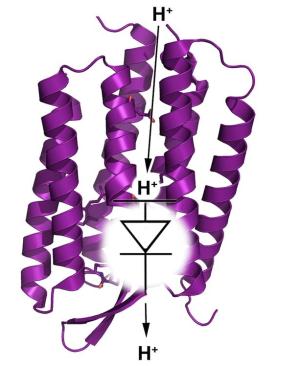
Jjust like the electronic component determines the direction of flow of electric current, the "proton diode" ensures that protons can only pass through a cell membrane in one direction. Water molecules play an important role here as active components of the diode.
The researchers led by Prof. Dr. Klaus Gerwert (Chair of Biophysics at the RUB) were able to observe this through a combination of molecular biology, X-ray crystallography, time-resolved FTIR spectroscopy and biomolecular simulations. They report in the international online edition of the journal Angewandte Chemie.
Protons drive the protein turbines
The proton diode plays an important role in the energy production of cells. Light-driven proton pumps - certain proteins that traverse the cell membrane - eject protons out of the cell, so that excess pressure is generated outside "much like the water pressure at a dam", explains Prof. Gerwert.
Elsewhere, the protons push back into the cells to compensate the concentration gradient, and thereby drive the turbines of the cell, proteins known as ATPases. The energy thus released is converted into the universal fuel of the cells, ATP (adenosine triphosphate). "This process is a kind of archaic photosynthesis" explains Prof. Gerwert. "The light energy is ultimately converted into usable energy for the organism".
We used to believe in chance
The details of these processes are the subject of research. In particular, the role of water molecules in proteins has long been unclear. "Previously it was believed that the water molecules blundered into the proteins by chance, and fulfilled no particular function", says Gerwert. Manfred Eigen, born in Bochum in 1967, was awarded the Nobel Prize for chemistry because he was able to explain why water and ice protons are such rapid conductors. The current work shows that proteins also use precisely this mechanism and that the water molecules do indeed carry out an active function in the protein.
Water is as important as amino acids
This result supports the hypothesis drawn up by Klaus Gerwert in 2006 in Nature that protein-bound water molecules are just as important catalytic elements for the function of proteins as amino acids, the building blocks of life. Consequently, the Bochum biophysicists have devoted their work in Angewandte Chemie to Manfred Eigen. Eigen also published his central thesis on proton transfer in water in Angewandte Chemie in 1964. Klaus Gerwert was inspired by Manfred Eigen's winter seminars in Klosters.
Film instead of fixed image
The Bochum researchers were able to achieve their results in an interdisciplinary approach through a combination of molecular biology, X-ray crystallography, time-resolved FTIR spectroscopy and biomolecular simulations. This combination shows the dynamic processes in the protein after light excitation with atomic resolution. "You can track how the proton is transported from the central proton binding site inside the protein via an amino acid and then via a protonated water cluster to the membrane surface", says Prof. Gerwert. The interdisciplinary approach is now expanding the classical methods of structural biology, X-ray crystallography and nuclear magnetic resonance spectroscopy (NMR), as it provides a complete film and not just fixed images of proteins. The experiments in Bochum were supplemented by computer simulations in Shanghai. Klaus Gerwert is both a professor at the RUB and Director of the Max Planck Partner Institute for Computational Biology in Shanghai.
Further Information:
Dr. Steffen Wolf, Erik Freier, Dr. Meike Potschies, Prof. Dr. Eckhard Hofmann, Prof. Dr. Klaus Gerwert:
Directional Proton Transfer in Membrane Proteins Achieved through Protonated Protein-Bound Water Molecules: A Proton Diode.
In: Angewandte Chemie International Edition; first published online: 2 August 2010, DOI 10.1002/anie.201001243
Florian Garczarek and Klaus Gerwert:
Functional waters in intraprotein proton transfer monitored by FTIR difference spectroscopy.
In: Nature; 439, 109-112, 05 January 2006, DOI 10.1038/nature04231
Source: Ruhr-Universität Bochum, RUB, Germany
Last update: 03.09.2010
Perma link: https://www.internetchemistry.com/news/2010/sep10/proton-diode.php
More chemistry: index | chemicals | lab equipment | job vacancies | sitemap
Internetchemistry: home | about | contact | imprint | privacy
© 1996 - 2023 Internetchemistry
